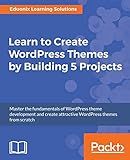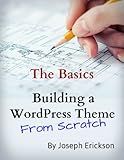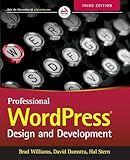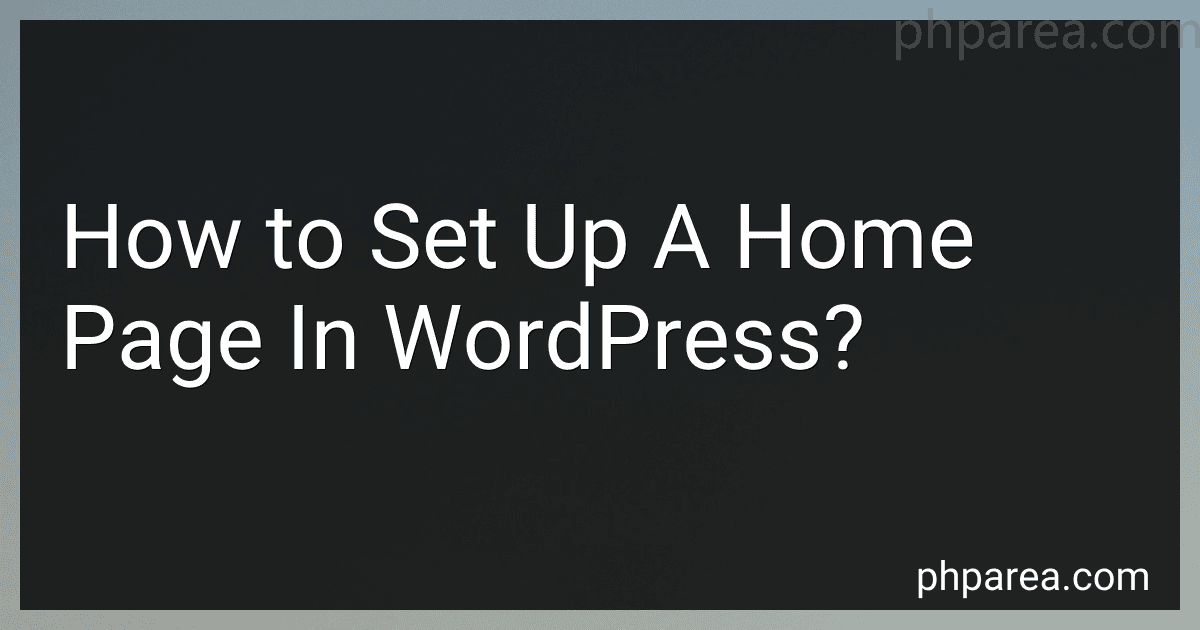Best WordPress Theme to Buy in December 2025

Learn to Create WordPress Themes by Building 5 Projects: Master the fundamentals of WordPress theme development and create attractive WordPress themes from scratch



WordPress Gutenberg: Creating layouts with the block editor



Building a WordPress Theme From Scratch: The Basics (For Designers)



The Web Developer's Guide to WordPress: Learn how to create WooCommerce compatible, customizable and redistributable themes



WordPress Power Toolkit: Harness AI to build next-level websites



WordPress To Go: How To Build A WordPress Website On Your Own Domain, From Scratch, Even If You Are A Complete Beginner



How I Made One Million Selling WordPress Themes: A Practical Guide to Selling WordPress Themes on ThemeForest



WordPress Explained: Your Step-by-Step Guide to WordPress (2020 Edition)



Professional WordPress: Design and Development


Setting up a homepage in WordPress is a crucial step in building your website. It serves as the landing page for your visitors and provides a summary of your site's content. Here's a brief guide on how to set up a homepage in WordPress:
- Log in to your WordPress dashboard using your login credentials.
- Navigate to the "Appearance" section on the left-hand side and select "Customize." This will open the WordPress Customizer.
- Within the Customizer, you may see options like "Homepage Settings" or "Static Front Page." Click on it to proceed.
- By default, WordPress displays your latest blog posts on the homepage. If you want to set a static page as your homepage, you need to create one first. Go to "Pages" in the WordPress dashboard and select "Add New" to create a new page.
- Give your new page a title, such as "Home" or "Welcome," and customize the content according to your preferences. You can add text, images, videos, or any other elements to make it engaging.
- After creating and saving your static page, return to the Customizer and select "A static page" option.
- From the dropdown menus, you should see an option to set your newly created page as the "Homepage." Select it as the homepage, and you can also choose another page as the "Posts page" if needed.
- Save the changes you made in the Customizer, and you've successfully set up your homepage in WordPress.
Remember, the appearance and customization options might differ depending on your WordPress theme and version. However, the basic process outlined above should help you set up a homepage on most WordPress platforms.
How to create a custom menu for my WordPress homepage?
To create a custom menu for your WordPress homepage, follow these steps:
- Login to your WordPress admin panel.
- Go to Appearance > Menus. This will open up the menu editor.
- Click on "Create a new menu" and give your menu a name, then click on the "Create Menu" button.
- On the left-hand side, you will see a list of available pages, posts, custom links, and categories. Select the items you want to add to your menu by checking the checkbox next to each item and clicking on the "Add to Menu" button.
- After adding the desired items to the menu, you can reorder them by dragging and dropping them in the menu editor. You can also create submenus by dragging an item slightly to the right below another item, creating a hierarchy.
- On the right-hand side, you can configure additional settings for your menu. For example, you can set a menu location if your theme supports multiple menu locations, or you can choose to display the menu in a specific location, like the primary navigation menu.
- Once your menu is ready, click on the "Save Menu" button to save your changes.
- Now, visit your homepage to see the custom menu you just created. If your theme does not automatically display the menu, you may need to manually add the menu to your theme's template files. You can consult your theme's documentation or reach out to the theme developer for instructions on how to do this.
How to add testimonials to my WordPress homepage?
To add testimonials to your WordPress homepage, you can follow these steps:
- Install a testimonial plugin: There are several testimonial plugins available in the WordPress plugin repository. You can choose one that suits your needs, such as Testimonials Widget, Strong Testimonials, or Easy Testimonials.
- Install and activate the plugin: From within your WordPress admin dashboard, go to "Plugins" > "Add New" and search for the testimonial plugin you've chosen. Install and activate the plugin.
- Configure the testimonial settings: After activating the plugin, you may need to visit the plugin settings page to configure its options. You can typically find this under the "Settings" or "Testimonials" menu.
- Create a new testimonial or import existing ones: Depending on the plugin, you may have the option to create new testimonials directly within the plugin's interface, or you can import testimonials from other sources. Follow the plugin's documentation or instructions on how to proceed.
- Customize the testimonial display: Most testimonial plugins provide various customization options. You can adjust the testimonial appearance, including the layout, font styles, colors, and more. Explore the plugin's settings and customization options to fine-tune the testimonial display to your liking.
- Add the testimonial widget to your homepage: Once you have configured the testimonials and customized the display, you can add the testimonial widget to your homepage. The exact method will depend on your WordPress theme and the plugin you're using.
- Widget Area: If your theme supports widget areas, you can navigate to "Appearance" > "Widgets" and drag the testimonial widget to the desired widget area on your homepage.
- Block Editor: If you're using the block editor (Gutenberg), you can search for the testimonial block provided by the plugin and add it to your homepage.
- Shortcode: Some plugins offer a shortcode that you can copy and paste into your homepage editor. Locate the shortcode and paste it into the desired location on your homepage.
- Save changes and preview your homepage: After adding the testimonial widget, save your changes and preview your homepage to see how the testimonials appear. Make any necessary adjustments to the design or display options if needed.
Note: The steps may vary slightly depending on the specific testimonial plugin you choose. Follow the documentation or instructions provided by the plugin developer for any additional guidance.
How to set up a blog style homepage in WordPress?
To set up a blog style homepage in WordPress, follow these steps:
- Log in to your WordPress admin dashboard.
- Go to Appearance > Customize to open the WordPress customizer.
- In the customizer, you will find a list of settings. Look for the option labeled "Homepage Settings" or "Static Front Page." Click on it.
- In the "Your homepage displays" section, select the "Your latest posts" option.
- Save the changes.
This will set your blog posts as the homepage of your WordPress site. WordPress will automatically display your latest posts on the homepage.
What is a homepage template in WordPress?
A homepage template in WordPress is a predefined layout or design that is used to display the main page of a website. It is a combination of HTML, CSS, and PHP code that controls the appearance and functionality of the homepage. The template typically includes various sections, such as header, footer, content areas, and sidebars, which can be customized and filled with content to create a visually appealing and informative homepage for a WordPress website.
How to add a newsletter subscription form to my WordPress homepage?
To add a newsletter subscription form to your WordPress homepage, you can follow these steps:
- Install a Newsletter Plugin: Go to your WordPress dashboard. Click on "Plugins" in the left sidebar. Click on "Add New." Search for a suitable newsletter plugin such as "Mailchimp for WordPress," "Newsletter" or "OptinMonster." Install and activate the chosen plugin.
- Set up the Newsletter Plugin: Look for the plugin in the WordPress dashboard menu. Click on the plugin's name to access its settings. Follow the on-screen prompts or documentation (specific to the chosen plugin) to set up the plugin. You might need to create an account with the chosen newsletter service provider if prompted.
- Create a Subscription Form: After configuring the plugin, locate the form builder feature provided by the plugin you installed. Create a new form or choose a pre-made template. Customize the form according to your preference. Typically, you can customize the form's appearance, fields, and placement.
- Add the Form to the Homepage: Once you've created the form, navigate to the page where you want to display the form. Edit that page or create a new one. Look for a button or tool provided by the plugin to insert the form. Click on the button or tool, select the form you created, and insert it into the page.
- Save and Publish: After adding the form, save the changes to the page. Preview the page to ensure the subscription form is displaying correctly. If everything looks good, publish the page.
Now visitors can see and use the newsletter subscription form on your WordPress homepage.
How to use a page builder to design my WordPress homepage?
To use a page builder to design your WordPress homepage, follow these steps:
- Install a page builder plugin: Go to your WordPress dashboard, navigate to "Plugins" > "Add New," search for a popular page builder plugin like Elementor, Beaver Builder, or Divi, and click "Install" and then "Activate."
- Create a new page: Go to "Pages" > "Add New" to create a new page that will serve as your homepage.
- Launch the page builder: Once the page is created, click on the "Edit with Elementor" (or the respective page builder you installed) button to launch the page builder interface.
- Choose a template or start from scratch: Depending on the page builder plugin you've selected, you'll have the option to choose from pre-designed templates or start creating your page from scratch. Choose the option that suits your needs.
- Customize the design: Use the page builder's drag-and-drop interface to add and arrange various elements on your homepage. You can typically add sections, columns, images, text blocks, buttons, and more. Customize the appearance, style, and layout of each element to match your preferences.
- Add content: Fill in your homepage with the desired content. This can include text, images, videos, testimonials, portfolio items, and any other relevant information. Some page builders provide specialized widgets and modules for specific content types.
- Configure page settings: Set the page attributes like page title, permalink, featured image, and other settings according to your requirements. These options are usually available in the WordPress editor sidebar.
- Preview and save changes: Use the preview function to see how your homepage looks. Make any necessary adjustments or fine-tuning. Once you're satisfied with the design, save the changes.
- Set your homepage: To use the newly built page as your homepage, go to "Settings" > "Reading" in the WordPress dashboard. Look for the "Front page displays" option and select the "A static page" radio button. Choose the page you created as your homepage from the drop-down menu.
- Publish your homepage: Click on the "Update" or "Publish" button to make your homepage live.
Remember to explore the different options and features provided by your chosen page builder plugin, as they may offer additional functionalities like animations, advanced styling options, and integrations with other plugins.
How to set up a countdown timer on my WordPress homepage?
To set up a countdown timer on your WordPress homepage, you can follow these steps:
- Install and activate a countdown timer plugin: Search for a countdown timer plugin in the WordPress Plugin Directory, such as "Countdown Timer Ultimate," "Evergreen Countdown Timer," or "T(-) Countdown." Install and activate the plugin of your choice.
- Configure the countdown timer settings: Once activated, go to the plugin's settings page, usually located in the WordPress dashboard menu.
- Set the countdown timer duration: Specify the date and time when the countdown should end. Enter the target date and time in the plugin's settings, following the format specified by the plugin.
- Customize appearance and style: Adjust the appearance of the countdown timer to match your website's design. Many plugins allow you to modify the colors, fonts, size, and style of the countdown timer. Explore the plugin's options and customize them to your preference.
- Choose the location for the countdown timer: Determine where you want the countdown timer to appear on your homepage. Some plugins provide a shortcode that you can add to any page, while others may add a widget that you can place in a widgetized area of your theme (such as a sidebar or footer). Use the method recommended by your chosen plugin to display the countdown timer on your homepage.
- Save and preview: After customizing the countdown timer settings, save the changes. Then, preview your homepage to ensure the countdown timer is displaying correctly.
By following the above steps, you should be able to set up a countdown timer on your WordPress homepage using a plugin.
How to add a sidebar to my WordPress homepage?
To add a sidebar to your WordPress homepage, you can follow these steps:
- Log in to your WordPress dashboard.
- Go to Appearance > Widgets. This is where you can manage your widget areas.
- On the left side, you will see available widgets. On the right side, you will see your theme's widget areas.
- Choose the widget area where you want to add a sidebar. Typically, theme options include "Primary Sidebar," "Secondary Sidebar," or "Main Sidebar." If your theme does not have predefined widget areas, you may need to add them manually or consider using a different theme.
- Drag and drop the desired widgets from the left side into the selected widget area on the right side.
- Customize the widgets as needed by filling in the content and adjusting settings. Some commonly used widgets include search, recent posts, categories, tags, and social media buttons.
- Once you've finished adding and configuring widgets in the sidebar, click the "Save" or "Publish" button to update your changes.
- Visit your website's homepage to see the sidebar in action. If it doesn't appear as expected, ensure that your theme supports sidebar display on the homepage.
Note: The steps may vary slightly depending on your WordPress theme or version. Always refer to your theme's documentation for specific instructions.
What is a sidebar in WordPress?
In WordPress, a sidebar refers to a widget-ready area located on the side of a webpage. It is a space where users can add various widgets to display additional content or functionality on their website. Sidebars are common in WordPress themes and can be customized to include menus, search bars, recent posts, social media icons, advertisements, and more. The sidebar can be easily managed and organized through the WordPress dashboard.
